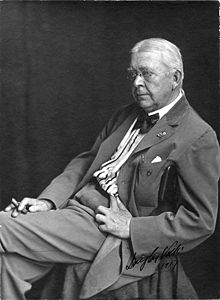DOUGLAS VOLK
1856-1935 Son of the noted sculptor Leonard Wells Volk (1828-1895), the genre, history, and portrait painter Stephen Arnold Douglas Volk was born in 1856 in Pittsfield, Massachusetts. Volk was named after his mother’s cousin, Abraham Lincoln’s political rival Stephen A. Douglas, whose surname he adopted as his first name. At the age of fourteen he accompanied his parents to Rome and began to attend classes at the Academia di San Luca; at that time he also received informal guidance from George Inness. In 1873 he went to Paris and, after Leon Bonnat made a disparaging remark about one of his drawings, transferred to the École des Beaux-Arts where he studied under Jean-Leon Gerôme for the next two years. Gerôme referred to Volk and his fellow student and friend George de Forest Brush as his “twins” because they looked alike and were frequently seen together. Volk exhibited his first major painting, “En Bretagne”, at the Salon of 1875, and in the following year when visited America was one of the youngest exhibitors at the Centennial Exposition in Philadelphia.
Son of the noted sculptor Leonard Wells Volk (1828-1895), the genre, history, and portrait painter Stephen Arnold Douglas Volk was born in 1856 in Pittsfield, Massachusetts. Volk was named after his mother’s cousin, Abraham Lincoln’s political rival Stephen A. Douglas, whose surname he adopted as his first name. At the age of fourteen he accompanied his parents to Rome and began to attend classes at the Academia di San Luca; at that time he also received informal guidance from George Inness. In 1873 he went to Paris and, after Leon Bonnat made a disparaging remark about one of his drawings, transferred to the École des Beaux-Arts where he studied under Jean-Leon Gerôme for the next two years. Gerôme referred to Volk and his fellow student and friend George de Forest Brush as his “twins” because they looked alike and were frequently seen together. Volk exhibited his first major painting, “En Bretagne”, at the Salon of 1875, and in the following year when visited America was one of the youngest exhibitors at the Centennial Exposition in Philadelphia.
Volk continued to study with Gerôme in Paris until 1879, when he permanently returned to America and initiated a lifelong career in art education by accepting a professorship at the Cooper Institute in New York City, where he taught until 1884. In 1881 he married Marion B. Larrabee of Chicago, by whom he had four children. He was elected to membership in the Society of American Artists. In 1886 he founded the Minneapolis School of Fine Art, Minnesota (now the Minneapolis College of Art and Design) and served as its director until 1893. During his stay in Minnesota, Volk executed murals in the state capitol at Saint Paul. He was made a member of the national jury of selection for the 1893 Chicago Columbian Exposition where he also exhibited three paintings, one of which was awarded a medal. Volk moved back to New York and became an instructor at the Art Students’ League until 1898. He also taught classes at the New York Society for Ethical Culture, and his moral philosophy of art was greatly influenced by the society. He was elected associate member of the National Academy of Design in 1898, and was made a full member in the following year. He taught a class in portraiture at Cooper Union from 1906 to 1912, and was an instructor at the National Academy of Design from 1910 to 1917. He was one of eight American artists selected in 1919 by the National Art Committee to paint portraits of distinguished American and Allied leaders for a pictorial record of World War I, a project for which he executed portraits of King Albert of Belgium (who awarded him the Cross of the Order of Leopold II in 1920), Premier Lloyd George (Smithsonian’s American Art Museum, Washington, D.C.), and General John J. Pershing (National Portrait Gallery, Washington, D.C.). During the last fifteen years of his life Volk painted a series of posthumous portraits of Abraham Lincoln. Throughout his long career Volk received numerous awards and distinctions, and was a member of many artists’ organizations. While living at their summer retreat “Hewnoaks” in Center Lovell, Maine, Volk, and to a greater extent his wife, contributed to the American arts and crafts movement by producing homespun wool rugs of exceptionally high quality. He died in nearby Fryeburg, Maine, in 1935.
Volk established his reputation by painting romanticized historical subjects depicting life in Colonial America, especially scenes of seventeenth century Puritan society. He later became an accomplished portraitist, and his oeuvre reflects a mastery of Gerôme’s academic style in its skillful draftsmanship, composition, and high degree of individuality in choice of subject matter. Throughout the developmental years of modernism Volk never abandoned allegiance to his traditional academic training, and his reputation consequently lapsed into obscurity, but with the revival of interest in American academic painting he has received a measure of recognition.
